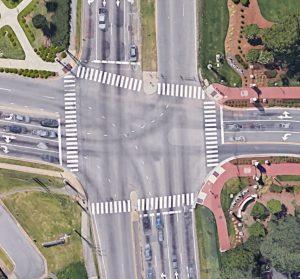Testing the Value of Mobile Device Communication with Traffic Control Infrastructure for Pedestrians with Visual Impairments
Travelers who are blind, or have other disabilities, are dependent upon accessible pedestrian signals to extend the walk cycle at complex actuated intersections. These travelers benefit greatly from accessible pedestrian signals (APS), but also have difficulty with them due to being pulled from their intended trajectory in order to locate and press the pedestrian push button.
The objective of this project is to explore mobile device user initiation of the walk signal through a wireless communication with the traffic controller, avoiding the need to find and press the pedestrian button. This research has been greatly accelerated by the development and initial deployment of a similar system made by one of the engineering venders. The Polara company has developed a system similar to that imagined by this project and has implemented its use in two key cities in North Carolina: one installation in Greensboro and two in Raleigh. This moves our research from exploratory in nature to proof of value. Rather than having to build a prototype, our project is instead now able to utilize the existing installations to test its value with pedestrians.
The PedApp® by Polara can be used on a smartphone to request the walk phase of the traffic cycle. For individuals who are blind or visually impaired, the system works with the VoiceOver (Apple) or TalkBack (Android) text-to-speech system to provide verbal information on their phones.
This system allows our research to test various functions and determine what best meets the needs of the pedestrian. These include bypassing the physical button, calling for the names of the streets, and initiating an audible countdown of the remaining time to finish the crossing. For individuals who have low vision or non-visual disabilities and can more easily find the pedestrian button, it also allows us to test a variation of simply calling the phase by waving one’s hand in front of the button.
The accompanying photo is an example of the type of intersection for which such a system would be beneficial.

